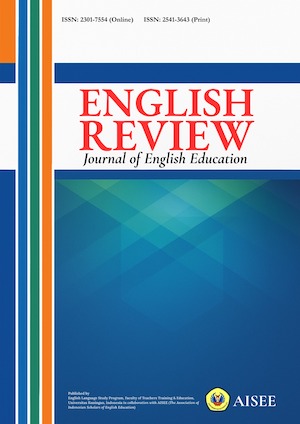IMPLEMENTING ADVERTISEMENT FOR IMPROVING STUDENTS’ UNDERSTANDING OF POLITENESS AND GENDER
Abstract
This research was based on students’ difficulties in understanding the concept of politeness and gender. Advertisement can be one of the alternative techniques to improve students’ understanding on the concept of politeness and gender. This study aims at improving students’ understanding of politeness and gender and finding the factors influencing the improvement. This Classroom Action Research involved ten third-year-students at STIBA Persada Bunda Pekanbaru. The data collection techniques used were tests, fieldnotes, observation, and interview. The results showed that students’ understanding of politeness and gender significantly improved after applying advertisements in the teaching and learning process in which the students’ understanding which were at the low level category increases to the good level category. Some factors affecting the students’ improvement were students’ active participation in obtaining information and students’ enthusiasm during the learning process. In conclusion, the implementation of advertisements can improve students’ understanding of politeness and gender concepts.References
Aini, L. M. (2016). Women language used by the main characters of “Mockingjay” movie. UnpublishedThesis. English Language and Letters Department: Maulana Malik Ibrahim State Islamic University of Malang.
Bansal, M., & Gupta, S. (2014). Impact of newspaper advertisement on consumer behavior. Global Journal of Finance and Management, 6(7), 669-674.
Culpeper, J., Haugh, M., & Kádár, D. Z. (Eds). (2017). The palgrave handbook of linguistic (im)politeness. London: Palgrave Macmillan.
Elmianvari & Kheirabadi. (2015). The study of EFL students’ requests based on politeness theory. Journal of Language Teaching and Research, 4(2), 375-385.
Hameed, W. Q. (2010). The impact of gender in determining politeness strategy with reference to Iraqi students of English. Journal of the College of Arts, 54(2), 38-56.
Harfoushi O., Alfawwaz, B., Obeidat, B., Obeidat, R., & Faris, H. (2013). Impact of internet advertisement and its features on e-commerce retail sales: Evidence from Europe. Journal of Software Engineering and Applications, 6, 564-570.
Holmes, J., & Wilson, N. (2017). Learning about language: An introduction to sociolinguistics. Essex: Pearson Education Ltd.
Hornby, A. S. (2018). Oxford learners’ dictionary (Online). Retrieved from https://www.oxfordlearnersdictionaries.com/definition/english/a-s-hornby.
Karimkhanlooei, G., & Vaezi, N. (2017). Politeness strategies in written communications: The issue of Iranian EFL learners. Jolace: Journal of Language and Cultural Education, 5(3), 108-126. doi: 10.1515/jolace-2017-0031.
Meyerhoff, M. (2018). Introducing sociolinguistics (3rd ed.). New York: Routledge.
Pangestuti, W. (2015). Politeness strategies used by Deddy Corbuzier in interviewing entertainer and nonentertainer in “Hitam Putih” talk show. Unpublished Thesis. English Department: University of Diponegoro.
Siddiqui, S., & Singh, T. T. (2016). Social media and its impact with positive and negative aspects. International Journal of Computer Applications Technology and Research, 5(2), 71-75.
Stamatelou, M. (2015). A reflection on the use of Advertisements in enabling language learning in the EFL classroom. Elted, 17, 27-34.
Strumska-Cylwik, L., & Ibrahim, F. (2014). Gender relationship and media language: A comparative study of print media in Poland and Malaysia. International Journal of Arts & Sciences, 7(5), 647–682.
Wambui, N. S. (2014). Linguistic politeness strategies in bank advertisements: A case study of Kenya commercial bank. Unpublished Thesis. Department of Linguistics and Languages: University of Nairobi.
Wardhaugh, R., & Fuller, J. M. (2015). An introduction to sociolinguistics (7th ed.). Oxford: Wiley Blackwell.
All articles published in English Review: Journal of English Education (ERJEE) are licensed under the Creative Commons Attribution 4.0 International License (CC BY 4.0).
Copyright Ownership
Authors retain the copyright of their articles and grant ERJEE the right of first publication. The journal is granted a non-exclusive license to publish, reproduce, and distribute the article in any format, medium, or platform, provided that proper credit is given to the original authors.
License Terms – CC BY 4.0
Under the Creative Commons Attribution 4.0 International License, others are free to:
- Share — copy and redistribute the material in any medium or format
- Adapt — remix, transform, and build upon the material for any purpose, even commercially
As long as they:
- Provide appropriate credit to the original author(s) and source
- Provide a link to the license (https://creativecommons.org/licenses/by/4.0/)
- Indicate if any changes were made
There are no restrictions on the reuse, reproduction, or adaptation of published articles as long as attribution is properly given.
Author Warranties
By submitting a manuscript to ERJEE, authors confirm that:
- The work is original and does not infringe any existing copyright.
- The manuscript has not been previously published and is not under consideration elsewhere.
- All sources and references are appropriately acknowledged.
- Necessary permissions have been obtained for any copyrighted materials used.









